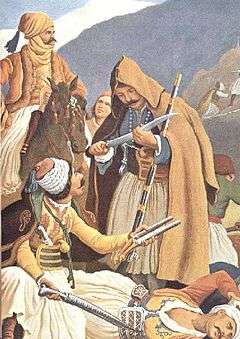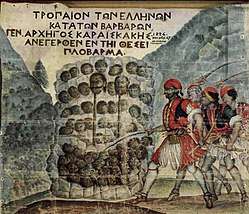Battle of Arachova
| Battle of Arachova | |||||||
|---|---|---|---|---|---|---|---|
| Part of the Greek War of Independence | |||||||
 "The battle of Arachova" by Peter von Hess | |||||||
| |||||||
| Belligerents | |||||||
|
|
| ||||||
| Commanders and leaders | |||||||
|
|
| ||||||
| Strength | |||||||
| 450 | 2,800 | ||||||
| Casualties and losses | |||||||
| Light |
1,700 killed[1] 50 captured | ||||||
The Battle of Arachova (18–24 November 1826) was fought between an Ottoman Empire force under the command of Mustafa Bey and Greek irregulars under Georgios Karaiskakis. On 18 November, Mustafa Bey's 2,000 Ottoman Turkish troops were blockaded in the village of Arachova. An 800-man Turkish force that attempted to relieve the defenders three days later failed. On 22 November Mustafa Bey was mortally wounded and tensions quickly rose between the new commander Kehagias and his Albanian officers as morale plunged. At midday on 24 November the Ottomans made a disastrous attempt at breaking out. Most were killed in the fighting or perished from hypothermia.
Background
Following the conclusion of the Third Siege of Missolonghi on 10 April 1826, fighting was restricted to the Siege of the Acropolis and skirmishes around Palamidi. The Ottomans seemed to have gained the upper hand in Central Greece, with many Greek rebels accepting Kioutahi Pasha's amnesty in order to take a break from the hardships of the Greek War of Independence. Georgios Karaiskakis took a number of fighters from Missolonghi, heading south towards Morea. On 27 October he arrived at Domvrena, besieging the 300-man Ottoman garrison who had taken refuge in tower houses. On 14 November, Karaiskakis broke off the siege after receiving news that Mustafa Bey's 3,000 man army had begun its descent towards Amfissa, putting the Greek forces in the area in grave danger. On the early morning of 16 November, Karaiskakis reached the Hosios Loukas monastery, spending the rest of the day there. Shortly before the dawn of 17 November, Greek troops set camp at Distomo. On the same day Mustafa Bey dispersed Greek pickets at Atalanti, later camping at the Agia Ierousalim monastery outside Davleia. There he questioned the local igumen about Karaiskakis' whereabouts and whether he knew of his intention to relieve Amfissa. The igumen lied, claiming that Karaiskakis had yet to leave Domvrena and that he was oblivious of the Ottoman maneuvers. Mustafa Bey believed him, nevertheless ordering his soldiers to keep an eye on the monks and promising to execute them should one of them try to betray his presence at the monastery. While Mustafa Bey and his aide Kehagias discussed their future plans while dining, a monk who was fluent in Turkish overheard their conversation. The monks convened in secret, deciding to dispatch one of them to Distomo and inform Karaiskakis of the route the Turks were to take. A young monk named Panfoutios Charitos managed to bypass the Turkish sentries twice, speaking with Karaiskakis and returning to his bed before the Turks recounted the number of the monks present.[2]
Karaiskakis immediately ordered his officers Georgios Hajipetros, Alexios Grivas and Georgios Vagias to occupy the church of Agios Georgios in Arachova and the surrounding houses. They were to strike the Turks with a force of 500 men once their enemies emerged from Mount Parnassus. Small bands were stationed between Arachova and Distomo in order to signal the outbreak of hostilities, at which point the main force would come to their aid. Christodoulos Hajipetros and his unit of 400 men covered a passage south of Arachova. Karaiskakis' secretary then sent messages to all known guerrilla bands in the surrounding areas, informing them of the impending battle.[3]
Battle

At 10 a.m. on 18 November, Greek lookouts signaled that the Turks were approaching Arachova from the north–east. An advanced column of Turks arrived at the village and was waiting for the rest of the army when Albanian soldiers noticed that several houses had freshly carved loopholes. Taking cover behind huge rocks standing inside the village they initiated a firefight with the Greeks. This came as a surprise to the majority of the villagers who had remained oblivious of the situation until the last minute; they now fled in panic in fear of future reprisals. Turks continued to funnel fresh troops into the village, steadily approaching the Greek positions which were the source of continuous volleys of shots. In the meantime Christodoulos Hajipetros' troops redeployed to the Kumula hill overlooking the village from the south. Karaiskakis' troops appeared on the outskirts of Arachova around midday, rebels from the surrounding areas gathered west of the village thus completely encircling the Turks. Mustafa Bey reacted by sending a detachment of 500 infantrymen to hold Karaiskakis' advance. The rest of the Turkish army occupied a hill overlooking the village.[4]
Upon descending the Maura Litharia hillock the Greeks were engaged by the Turkish detachment that had barricaded themselves inside houses. A quarter of an hour later the Turks had successfully repelled an attack, moreover the Greek right flank broke ranks and fled. The situation was reversed when a unit of Souliotes under Georgios Tzavelas mounted a second offensive, killing a Turkish officer and rallying deserters to return to the battlefield. Morale in the Turkish right flank plunged, those who managed to escape were intercepted west of the village and annihilated. Yet the Ottoman center and left flank held fast and Karaiskakis sought other ways to break the stalemate. 300 Greeks under Giotis Danglis passed west of the Zervospilies hill, taking a hill which was even higher than that the main Turkish force had occupied. This came as a complete surprise to Mustafa Bey, who led a Turkish counter attack, sword in hand. Being favored by the terrain, the Greeks crushed three waves of attackers within half an hour. In the meantime Karaiskakis overcame the resistance that faced him, reaching the Agios Georgios church. The Turkish camp was surrounded and besieged just as night fell and hostilities were suspended.[5]
On 19 November, the two sides exchanged fire, causing only minor damage to each other's barricades. The rest of the day was uneventful. In the early hours of 20 November, the Greeks received 450 men in reinforcements, most of them were sent on guard duty to the roads leading to Arachova. On 21 November, 800 soldiers under Abdullah Aga appeared outside Davleia where they broke into two forces. The smaller marched down to the Agia Ierousalim monastery while the larger headed towards Zemeno. Zemeno was to be the point where Abdullah Aga would strike the Greek rear, enabling Mustafa Bey to break out of the pocket. The formation was to act as a distraction.[5]
Mustafa Bey's troops hurriedly attacked Zemeno before Abdullah Aga's arrival and were pushed back. In the meantime, Abdullah Aga's vanguard was ambushed at a narrow passage leading to Zemeno. 30 Turks were killed and many were wounded before a disorganized retreat was conducted; the rebels captured 80 animals packed with supplies. The situation in the Turkish camp was desperate as cold weather and heavy rainfall struck the hunger-stricken defenders. Soldiers pressured Mustafa Bey into negotiations. Karaiskakis demanded that the Turks hand over all their weapons and money, give Kehagias and Mustafa Bey's brother as hostages, abandon Livadeia and Amfissa, promising safe passage in return. The terms were rejected, by a messenger who exclaimed "War!" three times. In the morning of 22 November, Karaiskakis ordered salvos to be fired on the Turkish camp from all sides. Mustafa Bey who had emerged from his tent to encourage his troops was mortally wounded in head. On the following day Kehagias assumed command, as a snowstorm swept through the area. Once Mustafa Bey's condition became known to his officers, the Albanian officers threatened to lay down arms unless the terms of the Greeks were satisfied. On the midday of 24 November, 700 Ottomans charged at a small picket guarding the road towards the Agia Ierousalim monastery. At the same time, Abdullah Aga ordered the retreat of his forces. Although the initial breakout was successful the Greeks regrouped, splitting the Turks in half. The 500 Turks who still held the camp were surrounded and slain, as were most of those who broke out. The soldiers who encountered Kehagias ignored his pleas for mercy as they did not speak Turkish, killing him.[6]
Aftermath
Out of the initial force of 2,000 only 300 Turks survived the onslaught escaping with the help of a Greek turncoat; most of them perished from hypothermia. The Greeks took 50 prisoners, most of whom also died from the effects of hypothermia. The Greeks also captured all the pack animals that were still alive, 23 flags and large amounts of weaponry and ammunition. The heads of Mustafa Bey and Kehagias were placed atop a conic tower of 300 severed heads, in accordance to Turkish tradition. The victory was widely celebrated in liberated areas of Greece.[7]
Footnotes
- ↑ Jaques, Tony (2007). Dictionary of battles and sieges : a guide to 8500 battles from antiquity through the twenty-first century (1. publ. ed.). Westport, Conn. [u.a.]: Greenwood Press. p. 61. ISBN 0313335370.
- ↑ Charitos 2001, pp. 17–20.
- ↑ Charitos 2001, pp. 20–24.
- ↑ Charitos 2001, pp. 25–28.
- 1 2 Charitos 2001, pp. 28–33.
- ↑ Charitos 2001, pp. 33–43.
- ↑ Charitos 2001, pp. 44–54.
References
- Charitos, Georgios (2001). Η Μάχη της Αράχωβας υπό τον Στρατάρχη Γ.Καραϊσκάκη και οι συντελεσταί της [The Battle of Arachova under Commander G. Karaiskakis and its participants] (in Greek). Athens: Dimos Arachovas.
| Wikimedia Commons has media related to Battle of Arachova. |